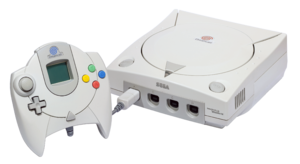Dreamcast
sixth-generation home video game console developed by Sega From Wikipedia, the free encyclopedia
The Dreamcast[a] is the fourth and last home video game console made by Sega. It was sold before the PlayStation 2, GameCube, or Xbox came out. However, not many people bought it after the PlayStation 2 was released, so in the end Sega decided to stop making them.[2]
 | |
| Manufacturer | Sega |
|---|---|
| Type | Video game console |
| Generation | Sixth generation era |
| Release date | November 27, 1998 September 9, 1999 September 9, 1999 October 14, 1999 |
| Units sold | 8.6 million[1] |
| Media | 1.2 GB GD-ROM |
| CPU | 200 MHz Hitachi SH4 RISC |
| Storage | VMU, Nexus Memory Card |
| Online services | SegaNet Dreamarena |
| Best-selling game | Sonic Adventure |
| Predecessor | Sega Saturn |
Making the Dreamcast
When it was time to make another video game machine after the Sega Saturn was released, Shoichiro Irimajiri asked Tatsuo Yamamoto from IBM Austin and his group to create it. However Hideki Sato's old group that made video game machines did not like this. Because of this, the two groups were in a competition to make the best machine.
Hideki Sato's group used Hitachi SH4 and PowerVR to make a video game machine called "White Belt". The name was later changed to "Guppy" and then "Katana".
Tatsuo Yamamoto's IBM/Motorola PowerPC 603e and 3dfx Voodoo 2 to make a video game machine called "Blackbelt" and then renamed to "Shark" in United States. In Japan, the machine was first called "Dural" and then renamed to "Katana".
In April 1997, 3dfx told people that Sega was using their 3dfx Voodoo 2 for a video game machine. Sega however wanted this to be a secret and became very angry. Because of this, Sega used Hideki Sato's "Katana" machine instead of Tatsuo Yamamoto's.
Later on, 3dfx sued Sega because they thought Sega broke their promise to them.[3] However, the two companies then settled out of court.
Launch
The Dreamcast was released in Japan on November 27, 1998, and then released September 9, 1999 in North America. At first, many people liked the Dreamcast and it sold a lot. In the United States, 300,000 machines were sold on the first week and Sega earned $98.4 million.
To help the Dreamcast sell even more, Sega told many stores to show some of their best games to customers, like Soul Calibur, Sonic Adventure, Power Stone, and Hydro Thunder.
Electronic Arts, a video games company, said that they did not want to make games for the Dreamcast until it sold one million machines. This is because Electronic Arts' video games on the Sega Saturn did not make a lot of money. However, in three months when the Dreamcast did sell one million machines, Electronic Arts still did not want to make games for the Dreamcast and made games for the PlayStation 2 instead.

Outside the USA and Japan
In places like Europe, Sega decided to let other companies make ads for the Dreamcast. However, Sega did not give the companies enough money, so the companies could not make as many ads as the PlayStation 2, another console that was competing with the Dreamcast.
Many of these companies also forced people to pay more for the Dreamcast than in the United States and Japan.
Some games were not even sold in Europe, because Sega was more focused on selling the Dreamcast in the United States. Because of this, a lot of people who used to like Sega now liked Sony.
Competition
After Sega released their Dreamcast, many other video game companies also released their video game consoles. This includes Sony, who released the PlayStation 2, which had the advantage of using the DVD-ROM format and being backwards compatible; Nintendo, who released the GameCube; and Microsoft, who released the Xbox.
End of the Dreamcast
Sega's prestige among gamers was at the time heavily damaged because of the lack of good management/marketing back from the Sega Saturn, this also affected certain game developers such as Electronic Arts refusing to develop for the system because of the risk of the Dreamcast becoming just like the Sega Saturn, not selling well. This was a factor is why this console did not reach its full potential.
Even SEGA's own CEO at the time, Isao Okawa, wanted to leave the console business.
In the end, Sega told people on January 31, 2001 that they would be stopping the console production. Sega's last video game sold for Dreamcast was Puyo Pop Fever, which was released on February 24, 2004.
Accessories
These accessories were sold by Sega to be used on the Dreamcast:
- Visual Memory Unit
- Controller and Rumble Pack
- VGA Adapter
- Mouse and keyboard
- Fishing Rod
- Microphone
- Lightgun
- Arcade Stick
- Twin Sticks
- Dreameye
- Samba de Amigo controller
Cancelled
- VMU/MP3 player
- DVD player
- Zip drive
References
Other websites
Wikiwand - on
Seamless Wikipedia browsing. On steroids.
